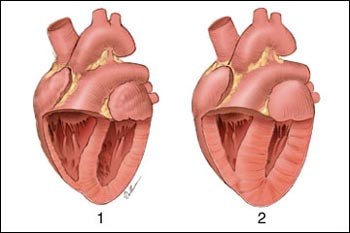Cardiomyopathy is a term that is used to describe diseases of the heart muscle. There are many types of heart disease, but cats generally develop three different forms of heart muscle disease: dilated cardiomyopathy, restrictive cardiomyopathy, and hypertrophic cardiomyopathy. Each of these conditions is different, but ultimately they cause problems because the heart becomes unable to pump an adequate volume of blood to supply the demands of the body.
Just like humans, cats can have heart disease for a long time before developing heart failure. A severe, life-threatening condition, heart failure occurs when the heart is no longer able to pump enough blood to supply the tissues with the oxygen they require. The right side, left side, or both sides of the heart can fail, causing a number of complications.

- Normal feline heart
- Feline hypertrophic cardiomyopathy
One of the most severe forms of heart failure occurs when the lungs fill with fluid, a condition called pulmonary edema. This complication occurs because the left side of the heart is not pumping blood effectively. Excessive pressure builds up behind the pump, and fluid leaks into the air spaces in the lungs. Thus, the cat effectively is drowning in its own fluids, which inhibits the exchange of oxygen between the lungs and the blood. The result is that the cells of the body do not receive enough oxygen and begin to die. If uncorrected, pulmonary edema leads to multiple organ failure and death.
Another complication of heart disease in cats is the development of a blood clot, clinically known as aortic thromboembolism, which usually forms in the heart and travels through the blood stream. Most commonly, the clot lodges at the branch of the aorta that feeds the back legs, shutting down blood flow and causing partial or complete paralysis. This condition is excruciatingly painful and requires immediate medical attention. Cats experiencing an aortic thromboembolism will be unable to move their back legs and may vocalize due to the pain. Aortic thromboembolism usually indicates significant heart disease; two thirds of cats that develop this condition will die or be put to death humanely. In cats that survive aortic thromboembolism, recurrence is common.





































